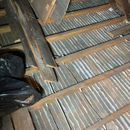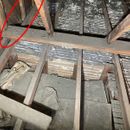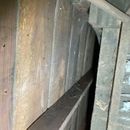1925 Home – Attic Insulation – Open Stud Cavities, Closet Chase, Misc
We have a 1925(ish) home in South Eastern Michigan (Detroit area) that has up until recently had no attic access. My wife was living in the home before we met. The home is very cold and drafty and we wanted to add attic insulation. We recently cut open an attic access to inspect and found about 2″ of compacted and very dirty fiberglass loose fill (dirty from emergency roof repair and age). The house is lath and plaster, including the attic floor/second story ceiling. We have two gable vents and a ridge vent that was installed during a roof repair, however the gap for the ridge vent is not very large. The house does not have space for soffit venting, although I’m wondering if the airflow from the open stud cavities through to the roof decking is a significant part of the ventilation scheme, given that we’re considering capping these open stud cavities off in order to better insulate the attic
We have removed 95% of the dirty insulation at this point and have an electrician working to remove and modernize the knob and tube up there.
We had two insulation contractors check it out just to get some bearings. One of them was shocked to find that a couple of the stud cavities were empty and led straight up into the attic space. We have since researched and found that empty stud cavities opening into an attic on a home of this age are not entirely unusual, and that these types of houses were designed to breathe (in a sense) in order to remain dry.
One contractor suggested blowing loose fill down into the walls, however we have since learned that this is often a bad idea since it can trap and hold moisture against the studs and walls. Others had suggested using rigid form to ‘cap’ these cavities off and can/gun foam the rigid into place. We were nervous about this, but have since seen posts indicating that these houses breath plenty regardless of capping those cavities, and that we should be ok.
There are also three closet areas that ‘drop down’ and are kind of empty cavities that have been filled with random wood and cardboard over time (now removed). When my wife had a blower door test before we met, these closet areas were where they said the air was moving right up and out. Both contractors suggested using rigid to cap these off, although one suggested filling it with bat before doing it. The other said this would be a waste of money if we seal it in because it was now ‘dead air space’.
We have a couple of questions:
1. Does capping these stud cavities off with rigid foam (+ spraying it in place) present any kind of problem in terms of trapping moisture in a house of this age? Right now the whole thing seems like a giant flue with our money flowing straight up and out!
2. Is the approach to secure some rigid foam in place over the closets seem sound? And if so, is there any point in putting some loose fill or bat in those dead air cavities (the space is on average lets say 4’x4′ and drops down about 2′).
3. It seems like cellulose is such a better insulator, the only concern we have is that the roof pitch is somewhat high, and also that we do seem to have a lot of air leakage in the home, potentially carrying moisture with it. Is there any reason we should consider fiberglass over cellulose in an attic of this type/age?
We have included some before and after photos of the attic. My apologies if they’re out of order. The one with the red circle is indicating one of the open stud cavities that runs along that entire side of the house. The openings appear on both the front and back walls, however the side walls do not appear to be entirely exposed in the same way.
Any and all suggestions and thoughts are much appreciated! We picked the wrong time of year to go there, but we’re half way through the woods and have to keep moving! 🙂
GBA Detail Library
A collection of one thousand construction details organized by climate and house part














Replies
Anyone have any thoughts on rockwool batts in the attic?
I keep hearing rave reviews about it, but was concerned about a) the weight of the product over an old lath & plaster ceiling, and b) the bat insulation issues (incomplete stoppage) vs. blown in. Any additional thoughts?
Rockwool is the right idea for sure. I actually prefer blown rockwool for attics, but batts will work also. Stay away from foam unless you’re going ALL IN and replacing siding, flashing, everything. There will always be air leaks, but at least the assembly will still dry - and the rockwool will help.
Thank you! How did you find a rock wool blower, or did you contract it out?